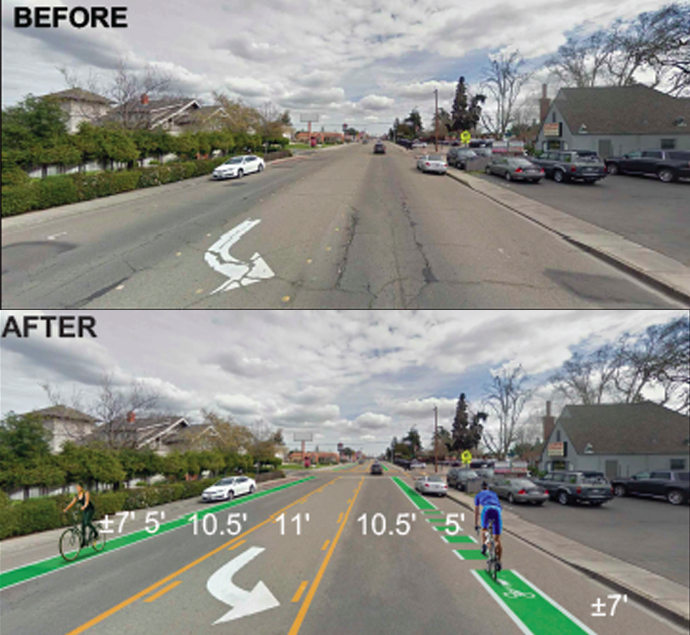Note: GJEL Accident Attorneys regularly sponsors coverage on Streetsblog San Francisco and Streetsblog California. Unless noted in the story, GJEL Accident Attorneys is not consulted for the content or editorial direction of the sponsored content.
The San Joaquin Council of Governments recently awarded $19.63 million from Measure K to help make the county more walkable and bike friendly.
Measure K is the county's half-cent transportation sales tax, originally passed in 1990. It was renewed by voters in 2006 with an added provision that thirty percent of its funds go toward pedestrian, bicycle, passenger rail and transit projects, with seven percent of that specifically for bike, ped, and Safe Routes to Schools projects.
County officials estimate that the measure will generate approximately $2.6 billion total through 2040, with 35 percent going to roadway repairs, 32.5 percent to “congestion relief” and 2.5 percent going to railroad crossing safety.
The recently allocated funds will pay for 21 projects in San Joaquin County, including about three miles of off-street bike paths, almost ten miles of on-street painted bike lanes, a little over a mile of signaled bike routes, and six miles of cycletracks, or on-street bikeways separated from traffic. In addition, it will add more than four miles of sidewalks, 117 crosswalks, and twelve flashing pedestrian crossing beacons, as well as pay for four plans and studies.
The size of the awards ranged from $2.2 million for a Safe Routes to School Sidewalk Network Completion Project at seven school locations in Stockton to $120,000 for a bike-share study the San Joaquin Regional Transportation Agency wants to undertake. The RTD study will analyze the feasibility of a bike-share program as a supplement for its transit services, similar to a program in Pittsburgh that gives transit riders free fifteen-minute bike rides when transferring from buses.
Emily Oestreicher, who works in RTD's marketing department, wrote to Streetsblog that “RTD has identified some gaps. . . where additional service will be beneficial to our customers and can be met through the implementation of a bike-share program.”
Some of the money going to Stockton is for projects prioritized in its recently adopted Bicycle Master Plan.
“These awards allow them to implement some of those projects right away,” said David Ripperda, an associate regional planner with SJCOG. One of those priority projects is a bikeway which will separate bikes from traffic with vertical delineator posts along South Airport Way between Martin Luther King Jr. Blvd and Performance Drive.
Ripperda said this is the first time the agency called for projects under a new process that combines funds from two Measure K programs. The change was made by the SJCOG board to streamline the process and invite more robust applications from jurisdictions.
The Measure K expenditure plan also specifies that at least $65 million will be made available for smart growth incentives. In this round, $3.85 million was available for the Bicycle, Pedestrian, and Safe Routes to School Competitive Program, $7.78 million for the Smart Growth Incentive Program, and an additional $8 million for projects in either program. The funding is for fiscal years 2017-18 through 2020-21.
While most of the money was awarded to Stockton-based projects and studies, smaller jurisdictions like Escalon, Lodi, Lathrop, Ripon and Manteca also got funding for bicycle and pedestrian improvements. For example, Escalon will get new sidewalks, crosswalks and pedestrian crossing signals, a landscaping buffer, and ADA improvements. Lodi will get money for a road diet on Church Street that will reduce traffic lanes from four to two and add a median and bike lanes, plus repair the sidewalk and add pedestrian countdowns to the signals.
Manteca was awarded more than $2 million for three projects and a study. Two of those projects are on Yosemite Avenue, an old highway that goes through downtown and past several schools, and at the Highway 120 overpass which will connect residents and amenities located on each side of the highway. The third project will add bicycle and pedestrian improvements to a planned “divergent diamond interchange”—the first of its kind in California—that is set to begin construction in August.
Funds were also awarded for a “non-motorized transportation study” for Manteca.
Koosun Kim, deputy director of public works for the city of Manteca, said this award will help the city move past just maintaining its existing facilities and allow it to build new ones that address Manteca’s growth.
“[Manteca] has changed a lot in the past ten years,” he said, adding that the proximity to the Bay Area and three major highways makes the city an attractive place for people to settle. “We are seeing a lot of traffic and a lot of bike activity,” he said. “Unfortunately, as the population grows we are also seeing more accidents.”
Kim said the non-motorized transportation study will help guide the city in the same way the Bicycle Master Plan has for Stockton, identifying and prioritizing projects.
“It’s a very important document for the city for the next twenty years,” he said.






